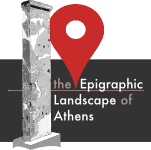IG 2[2] 1713Inscriptiones Graecae II et III: Inscriptiones Atticae Euclidis anno posteriores (2nd ed., Pars I-III, Berlin 1913-1940; Pars V: Berlin 2008), Ed. J. Kirchner
Inv. number
EM 10564 (formerly EM 8670)
PHI
Translations
AIO, AXON, IG Online
Images
Aleshire, Imaging Inscriptions, OSU Squeeze Collection, UBC Epigraphic Squeezes, ASCSA Net
Description
Date
41-54 AD
Period: 1st century CE
✓disputed
Reasons: historical context, prosopography
See notesThe inscription possibly dates back to the age of the emperor Claudius. It was certainly inscribed after 31 AD, since the last line of col. V bears the name of the eponymous archon of 30/1 AD ([...]τιος).
See Schmalz 2009 21 no. 13Schmalz G.C.R., «Augustan and Julio-Claudian Athens. A New Epigraphy and Prosopograhy», (Mnemosyne Suppl. 302), Leiden - Boston 2009
Text category
list (magistrates)
See notesThe stone bears the so-called "Great Archon Catalogue", a very important list of the eponymous archons of Athens in charge from 129/8 BCE to 30/1 AD.
In col. I (ll. 1-8) survive the names of the archons from 129/8 (Lykiskos) to 123/2 (Demetrios).
Col. II (ll. 9-16) bears five complete names for the years 91/0-86/5, while in the last two very fragmentary lines of the column we can read only the first letters of two names. This column represents a particularly significant testimony to the most troubled period for the history of the city in the I century BCE, marked by the Athenian support to Mithridates and the sack of Athens by Sulla. These events are reflected in the list in the three-years archonship of Medeios in 91/0, 90/89, 89/8 BCE and in the word ἀναρχία replacing the name of the eponymous archon for the year 88/7 BCE (l. 12). Dow suggested that in that year may have been appointed archon a man of Athenion, whose name was then replaced in the list as a sort of "damnatio memoriae", while Habicht thought even possible that the eponymous archonship of 88/7 may have been entrusted, as a honorific title, to Mithridates himself; see SEG 26, 144Supplementum Epigraphicum Graecum. Bugh would have later proposed the name of Aristion (SEG 42, 137Supplementum Epigraphicum Graecum).
In col. III (ll. 17-24) we can read eight names of archons from 55/4 (Aristod-/Aristox- ?) to 48/7 BCE (Philokrates).
Col. IV (ll. 25-31) bears the list concerning the years from 17/6 to 11/0 BCE (Theophilos). The name of the archon of 17/6 BCE, extremely fragmentary, may have been that of Apolexis of Oion [cf. ELA id: 215 (date)].
Ultimately, in col. V (ll. 32-39) there are the names of the archons from 23/4 (M-) to 30/1 AD (- - -tios).
The first editors, mainly Dittenberger and Kirchner, thought likely that the original list included the names of the archons from the sack of Corinth (146/5 BCE) until the settlement of the senatorial province of "Achaia" (43/4 AD), each column bearing 38 lines, that is 38 names of archons for each of the 38 years included between those two events:
col. I, 146/5-110/9 BCE;
col. II, 109/8-72/1 BCE;
col. III, 71/0-34/3 BCE;
col. IV, 33/2 BCE-5/6 AD;
col. V, 6/7-43/4 AD.
However, the text preserved does not allow to confirm this reconstruction.
Monument description
Monument type: stele
Material: white Pentelic marble
Letters Height Mt: 0.009
Physical features
Measurements: h: 0.37 * w: 1.00 * t: 0.155
State of conservation: The fragment preserves the left side, but is broken on top and at bottom side; the right side is badly worn
Reuse: Reused
Findspot
As Koumanoudis reported, the stone was found in the little chapel dedicated to St. Nicholas a little to the west of the Church of St. Philip, on the opposite side of Odos Adrianou by the North entrance to the Agora.
On these two churches see Mommsen 1868 nos. 125-126Mommsen, A., «Athenae Christianae», Lipsia 1868 and his plate, from which it would seem that on the western corner of Odos Adrianou and St. Philip's Square the chapel dedicated to St. Nicholas (now demolished) occupied the site by the western end of the Stoa Poikile and the Eridanos River channel in front of it. See also Shear Jr., Hesperia 66, 1997, 538-546Hesperia: The Journal of the American School of Classical Studies at Athens, 1932-
Date of discovery: 1860
Circumstances: archeological excavation
Kumanudes, Epigr.Hell. no. 11Koumanoudis S.A., Επιγραφαί ελληνικαί κατά το πλέιστον ανέκδοτοι: εκδιδόμεναι δαπάνη της εν Αθήναις Αρχαιολογικής Εταιρείας, Φυλλάδιον Α', Athenai 1860;
Pittakis, AEph 53, 1860, 196-1947 no. 3793Ἀρχαιολογικὴ ἐφημερίς: περιοδικὸν τῆς ἐν Ἀθήναις Ἀρχαιολογικῆς Ἑταιρείας, 1837- = APMA 5 no. 1827Malouchou G.E., «Εφημερίς Αρχαιολογική. Ευρετήρια περιόδου πρώτης 1837-1860» (AΡΜΑ V, Βιβλιοθήκη της εν Αθήναις Αρχαιολογικής Εταιρείας αρ. 265), Αθήναι 2010
Original location
The “catologi archontum” discovered by the archaeologists and published in the first section of IG 2[2] (pt. 2.2) - IG 2[2] 1696-1739Inscriptiones Graecae II et III: Inscriptiones Atticae Euclidis anno posteriores (2nd ed., Pars I-III, Berlin 1913-1940; Pars V: Berlin 2008), Ed. J. Kirchner - present between themselves quite different findspots, mainly due to reuse.
The inscriptions from the III century BCE seem to have been set up (or later reused) either on the Acropolis (no. 1705) or in the area of the Agora (nos. 1706, 1707).
The catalogues from the I century BCE (nos. 1715-1727) were discovered into a wide area stretching from the north slopes of the Areopagus (no. 1726) as far as the "Tower of the Winds" in the Roman Agora (no. 1715) and the streets of the Plaka (nos. 1716, 1717, 1719, 1723, 1727), but some examples also come from the Acropolis (no. 1720) or even from outside the “asty” (nos. 1718, 1721).
The catalogues dating back to the I century AD were instead found mostly on the Acropolis (nos. 1730, 1735, 1736), apart from an example found again by the Horologion of Andronikos (no. 1728) and one from the far-off suburban area of Marousi (no. 1729). Our text is the only example of that period coming from the area of the Agora and this may point to an original place of display in the ancient square itself, although we cannot rule out the possibility that, like other analogous texts dated to the same period, it has been set up on the Acropolis and then moved from the Rock down to the chapel of St Nicholas.
✓uncertain


